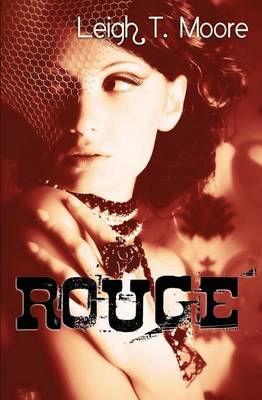From inception, Rouge drew me in with its shadowy, sparkling setting brought to life by Hale’s brave yet vulnerable voice. Its denouement surges forward, leaving my heartbeat racing and ready for more. It’s the middle--where stale, fair-weather love reigns--that drags ass across carpet seeking relief from blockage.
My first impression was similarities with Moulin Rouge. It’s not just its musical backdrop, but certain details like descending via swing and their secret affair songs. However, this isn’t necessarily a blow. Both works superbly showcase women surviving with little opportunity or hope yearning towards freedom.
It’s resemblance is sensible without pushing into wannabe status. For one, Moore’s protagonist is the opposite of Satine. Satine’s been around the block and dreams of becoming a real actress while just coming of age Hale wants, above all else, to protect her at risk ward.
Content Warning: Rape & Bigotry.
Graphic attack scene, forced prostitution, underlying and pervasive threats against women, POC, and LGBT.
The Good
Liked Hale, Teeny, and Roland
Loved finding out about Hale’s parent’s past
Their guardian/ward bond was compelling
Reminiscent of Moulin Rouge
The beginning and ending were captivating
The Bad & The Other
High-school-y insta-love
Her wavering over decisions was irritating
Predictable: didn’t see its outcome happening any other way
Middle section drags
After reading, feel a bit mislead by the blurb
Plotting Through Longueurs
Plot-wise, discovering her parent’s past was my favorite part; I wish there were more than mere scattered pieces. It's obvious who the antagonist is early so I missed this “mysterious” predator promised.
Further, their struggle over Teeny doesn’t take center stage until midway.
Before that, it’s a young woman playing Eeny, Meeny, Miny, Moe to pick a partner. Even afterwards, Hale waffles depending on how the wind blows. Eventually, circumstances conspire to force her hand. Throughout, I worried about quality of life rather than death-dealing injury, rendering its blurb zero for two.
Dragging out romantic indecision left me waiting for something to happen while reading most of Rouge. Realistically, there’s little choice for Hale and series direction, so plot felt stalled. When events finally unfold, it’s enjoyable yet predictable. I missed that shocking tension built resulting from unexpected revelations. Perhaps I’m too cynical though.
The Charismatic Characters
Surprisingly, my favorite character was someone who worked within the system rather than subverting it and encouraged Hale to stop safeguarding Teeny at her own detriment, in spite of disagreeing. Enter Roland: gay black man that writes the cabaret’s songs. His loyalty and practicality won me over. Hale’s noble instincts needed a sensible soundboard. His straightforwardness gave Hale an opening to do right even when her friends didn’t agree. He maybe a voice of reason but not one of conscience.
As realistic as it was, Hale’s “omg you’ll burn in hell for being that way” worrying made me sigh. Thankfully, she doesn’t come up often or hound him. But it's clear she's not the best friend, and it's not just her homophobic beliefs either.
She’s a compelling character, besides that and the Weeble wobble dance between beaus. Otherwise, she’d probably be my favorite. I liked Teeny in all her troublesome little sister-ness.
Hale and Teeny’s relationship is fundamental; this story wouldn’t exist without it. Hale maybe an orphan but she’s fairly fortunate, considering everything. Teeny represents what could’ve been though. While unable to enact change, at least one small girl can be saved from the horror stories Hale’s heard.
It’s admirable, intense, and charming. Of course, that doesn’t mean every motherly decision was agreeable. At first, it’s annoying how sheltered she kept Teeny because staying naïve is risky. Later, this revelation dawns and so begins worrying whether to educate or not. Thinking, “what if I’m causing my child harm or doing it wrong?” cemented her parenthood status for me.
Romantic Disinterest
Under such heavy responsibilities, it was hard cutting Hale slack although she’s young and clueless. I’ve been a single working teenage mom, seeing her gravitation towards an unfixed fling while spurring a secure relationship was irritating. Her snipe hunt made me feel vicariously embarrassed. At no time did I believe Beau’s prince charming act would come to fruition.
"Next time, don't let your guard down
because of a pair of big goo-goo eyes!"
Oh, look at his pretty eyes and cute smile! Add in sneaking around for make-out sessions and a jealous little sister, it’s no wonder the whole debacle felt high school-y. Beau gave the Charlie Brown football gag try, Hale got tingly as if he cuts off her circulation, and then they tangoed. The occasional tender moment with roses or the morning after wasn’t getting my motor running.
Bottomline:
3 stars for being an intriguing read with a likable heroine but instant noodle sweethearts and predictability left me wanting more.
Recommended for:
New Adult or Historical Romance readers, especially fans of Moulin Rouge’s sort. It’s a perfect chance to cheer on underdogs creeping towards their happily ever after by crossing a minefield. Be wary if high school-y love tropes aren’t your bag. Comes with a trigger warning for rape and bigotry.
